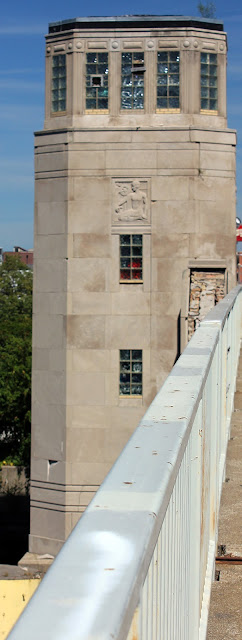 |
| click images for larger view |
A case in point is the Ashland Avenue bridge over the north branch of the Chicago River. It was part of a $50 million stimulus package from the FDR's Public Works Administration that built bridges, schools, and fire and police stations throughout Chicago.
The biggest component of the package was the new $7 million Outer Drive bridge, whose October 5, 1937 dedication was attended by no less than FDR himself. One year before, there had a more locally-based celebration for another component of the $50 million plan - the new Ashland Avenue bridge over the north branch of the Chicago river. It's dedication on August 20th, 1936 brought out 10,000 spectators. 80 associations participated in organizing a massive parade that began all the way down at 69th street, moved north to the bridge for the noon ceremonies, and then past it to Irving Park.
The $1,713,000 cost for the new bridge included $483,500 of PWA funding, bringing out agency head Harold Ickes to witness what he had got for his money. The balance came from the City of Chicago's share of Illinois motor fuel taxes.
Designed by City of Chicago architect Scippione Del Campo, the double-leaf bascule bridge has a span of 232 feet, an overall length of 386.5 feet, and a roadway width of 60 feet, with 12-foot sidewalks on either side. Tall steel pylons mark each entrance. The American Bridge Company of New York was the fabricator. The robust structure was visually anchored at either end by a tender house with art deco reliefs. 20,000 vehicles were projected to cross the bridge every 24 hours. The two Ashland Avenue bridges, including a second bridge dedicated along the southern branch the following year, were the culmination of a $22 million project to transform Ashland Avenue into “a modern highway 21 miles long.”
It's clear the long-neglected bridge needs some tender loving care. The windows of the tender houses have been replaced with glass block, now damaged. Of the four relief panels depicting the river as a heroic figure, the two on the north tender house seem in best shape.
 |
| river architect |
 |
| river mechanic |
. . . and dead branches overtaking the handsome relief like a spider capturing a victim in its web.
As far back as 2010, Blair Kamin was reporting that help was on its way, with the Chicago Department of Transportation promising to remove the overgrown vegetation, clean the gutters and provide other basic maintenance. Yet today, the bridge seems to have been left to rot. Complicating the process is that since Ashland is a county route, the bridge is technically owned by Cook County. CDOT is only responsible for maintenance.
The original Bedford limestone balustrades and pylons - nearly a mile's worth - are crumbling and collapsing.
In April of this year, the Chicago Art Deco Society filed a community recommendation with the Commission on Chicago Landmarks that the bridge be designated a Chicago Landmark. It's also one of the Chicago Bascule Bridges listed among 2013's Ten Most Endangered Historic Places list from Landmarks Illinois.
The Ashland Avenue bridge is an enormously attractive piece of civic infrastructure. Once such Art Deco panels could be found on the Ogden Avenue viaduct, but since the viaduct's demolition in 1995, the Ashland bridge is the only place where they survive. You can still see some of the Ogden panels in the St. Ignatius Architecture graveyard.
 |
| Ogden Viaduct panel |
 |
| Ogden Viaduct panel |
I suppose the Ashland reliefs could be added to St. Ignatius's holdings, but that's not really where they're most needed. It may be the kind of infrastructure that we use every today without really seeing, but the Ashland Avenue bridge, its tender houses and reliefs, are essential elements of Chicago's cultural history. They cannot be sacrificed without unmooring the city from the timeline that gives it meaning.
















